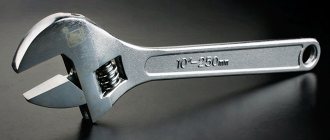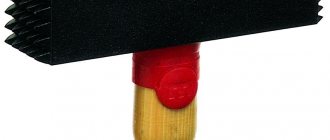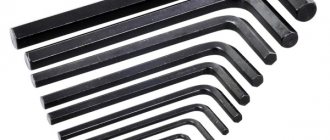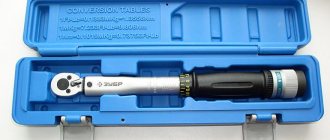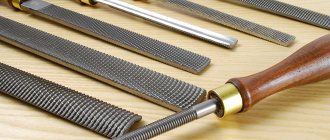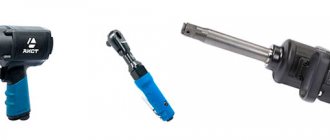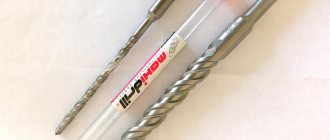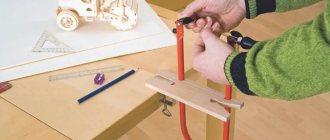I’ve been scouring the Internet for several days now, looking for a set of keys for my car. I’ve always wanted a jonneswey (and I still want one)), but I heard that the quality has dropped dramatically for everyone, I certainly believe in the quality that was 3-4-5 years ago, but here we are Now! What a quality it is. The budget is small, 5000 rubles maximum. Until recently, I had a set of DTs (ratchet, 8-32 heads, extensions 150, 250, cardan and spark plugs). I used them perfectly for about 5 years, everything works. There are few contenders (what I choose from) 1. Set of socket heads and wrenches Jonnesway S04H4125S (ombra-jonnesway.ru/katalo...2-mm-jonnesway-s04h4125s/) 2. Set of tools OMBRA OMT82S, 82 items (www.ombra- market.ru/produ…yuchi-8-22-mm-82-predmeta ) 3.KORUDA KR4026M — Set of socket heads ( www.autodoc.ru/part/koruda—7017/kr4026m/ ) 4.FORCE 4223 — Set of tools ( www.autodoc.ru/part/force—5917/4223/ ) 5.JTC JTCH085C ( www.autodoc.ru/part/jtc—6784/jtch085c/ ) The first contender for the purchase of Johnny, has been praised and recently criticized, supposedly Chinese g...but, a new brand with a lifetime warranty (although this is purely a marketing ploy) Koruda, the most affordable price. Force is also criticized for its quality, JTC seems to be a recent development for us, but it is also a professional instrument. My requirements for the set are quality and durability, not for 1 year, I mainly need 10-32mm running heads, a universal joint, extensions, maybe spark plug heads, preferably a metal case, do-it-yourself car repairs.
Jonesway bought 12 years ago. Only the large ratchet died, but the operation was harsh. Used even as a hammer. Force for five years already in auto service mode. Zero complaints. Dextel simple keys, three years in auto service mode, nothing to complain about. JTC heads are only impact were and are in stock. I won’t complain. Now I bought a set of King Tony drums, we survived the repair season calmly. The JTC impact wrench has only been a couple of months so far, I was pleased with the torque and low air consumption. I tried the Jonesway, but it wasn’t the same.
The stork is a good tool.
Stork has the same price as Jonesway, I bought myself a Joni so4h4125s, as soon as I use it a little I’ll write an opinion there
Greetings buddy. From the list that you showed, I would personally take the JTCH085C, provided that this is something you really need to buy right now. BUT! All the same, I would have suffered a little longer, saved up some money, my advice to you as a human being is - don’t rush! I'll tell you why. If you are already buying, then it is better to buy a set only with heads, you don’t need to have open-end wrenches, etc., because the cost is not small, but what you buy is not heads, and not open-end wrenches, etc. , that is, some kind of hybrid is not “this” and not “that”, which is not very useful in repairs. Here is my advice, buy from the companies you listed FORCE, JTC, or OMBRA will probably be more expensive, BUT, only one square heads 1/2″ and 1/4″ - 94 units, so you will already have a good set of heads to be confident twisting and tearing off a tightly tightened bolt/nut, and then you can fasten something with an open-end wrench - this is like a way out of the situation. Another tip 1, buy a set with only six-sided heads, they are much stronger than twelve-sided heads, a simple classic hex. Tip 2, DO NOT buy a set with hex heads that have a hexagon with large radii on the edges, they are also not needed (I emphasize, only a simple classic hexagon). Tip 3, for reliability in quality, buy from official representatives of this or that product. I would recommend FORCE 4941R-5 (94 items) (this seems to be a classic hexagon, which is what I was talking about) Good luck with your purchase.
Source: www.drive2.com
How do ratchets differ from each other?
To understand how ratchets differ, we will look at three tools from different manufacturers.
Let's talk about their features and technical characteristics that you should pay attention to when choosing this tool.
The first model of the Novosibirsk Tool Plant.
It is worth noting that this is the only plant that produces this instrument in Russia.
Spanners - advantages and disadvantages of modern sets and nuances of their choice (75 photos)
Every urban or rural resident should have spanners in their home tool arsenal, which will certainly come in handy for repairing any item. Especially if you own a car or any other equipment.
In an unforeseen situation, you will be sure that you can easily handle it with your own hands, having all the necessary tools. But not everyone has the knowledge of how to choose the right tool and which one is better. The presented photos will help you to take a closer look at the types of spanner wrenches.
Advantages and disadvantages
Socket wrench models are more convenient to use. For example, you need to unscrew an old rusty bolt. Using an open-end tool, you can easily damage the edges of the bolt head. As a result, you will have to use other tools (chisels and pliers), and this is a more complex process.
The ideal solution would be a regular socket wrench, especially if access to the bolt is not limited. The key profile rigidly fixes the part on all sides, which ensures the safety of all edges.
It doesn't require a lot of effort. As a result, we can conclude that the spanner wrench is convenient for securely fixing fastening parts.
Varieties and their nuances
The most common type of key is double-sided. Its handle can be straight or curved. The size of the wrench corresponds to the size of the nut, otherwise its operation will not last long, as the teeth will wear off. In addition to the advantages, there are also disadvantages. For convenient use of the key, free access to the fastener from all sides is necessary.
The key head can have a 6 or 12-sided profile; with a larger number of them, the angle of rotation will change to a smaller direction and the comfort of work will increase. Hexagons grip the nut better and practically do not lubricate the fastening corners.
A curved spanner is more convenient and versatile, which makes it more popular than a straight one. S-shaped keys with a hinge (ratchet) are worthy of special attention.
Using a spanner tool in hard-to-reach places, you can completely forget about open-end wrenches, but ratchet wrenches can also replace them, since there is no need to reposition them every time after turning them.
A small angle of rotation is enough to fix the nut, which is also one of its undeniable advantages. The ratchet can have 72 teeth. But to turn the key it will be enough to install it at an angle of 5 degrees.
Features of use
In normal use of the key, you need to put the ring on top of the fastening part to cover all the edges. In this case, contact occurs on 6 sides; in the case of using an open-end wrench, contact occurs on both sides. Therefore, you can apply more force without damaging the edges.
The shape of the head is also an advantage of the tool, since the force is applied at an angle without damaging the edges.
Pipe wrenches have a slightly different design (with a slot) to work with different pipeline connections.
Like open-end wrenches, spanners can be single-sided or double-sided.
Flat keys represent a special group, with both the ring (head) and the handle located in a single plane. In some embodiments, the heads may be bent at a slight angle.
In addition, you can use S-shaped or crescent-shaped crank wrenches, or wrenches with a hinged ring (head).
How to choose a spanner
The scope of application of open-end wrenches is very wide. This option involves a combination of two types of identical parameters on one handle.
When choosing, you should pay attention to the dimensions of the heads and handles, as well as the hardness of the material used for their production. Mostly tool or chrome vanadium steel with anti-corrosion coating is used
Keys should be used in accordance with the parameters of the fastening parts. The ideal purchase would be a full set of keys.
Characteristics of the first model
Turning the reverse on/off for this model is done by clicking the square core in the central part of the instrument from one side to the other.
When clicking the core, the key will need to be turned in the opposite direction than it was before clicking.
The head is held using a specially built-in spring ball, as shown in the picture above.
The working head of the tool can be put on and removed without much effort, but the seat square, when removing the head, may end up either in the key or in the head itself.
This is due to the simple design of the tool.
Simplicity is also expressed in the fact that this instrument has only 15 teeth.
The locking mechanism here is also very simple and consists of a gear with special grooves and a bushing.
The mechanism is stopped by a bushing that is pressed against the drum with a special plug.
As a result, the gear rotates in one direction and stops in the other, resting against the bushing.
A characteristic feature is that this all-metal tool has a plug made of plastic, which is a disadvantage.
Because As soon as you unscrew it and tighten it a couple of times, the thread on it wears off and it becomes unusable.
To extend its service life, you can use some polyethylene or the like as a seal.
Choosing a set
So, let's look at what a set of socket heads is. As a rule, it comes with a set of elements of different sizes and additional accessories, such as screwdriver bits, turning tools, and in complete sets you can even find wrenches.
The determining factor of a set is the number of items it contains. For example, the simplest and smallest kit includes 13 socket heads of different diameters and types. More complete sets can contain up to 573 components.
The versatility of such kits depends entirely on the number of elements included in it. Large sets containing more than 500 units are perfect for work in a large garage or auto repair shop.
When choosing similar sets, pay attention to the box or drawer in which the elements are located and stored. Practical carts or tool boxes are not only convenient to store, but also transport if necessary.
Small sets have advantages in size and lightness over large sets in size, but if we take into account the completeness of the set range, then small sets lose here.
When choosing heads for personal use, focus on the range of required sizes, which can expand and competently complement your tool collection.
Second model
This version of the tool is more popular than the previous model.
There are already 24 teeth, and there is a reverse flag, by switching which we get the reverse stroke of the tool.
This model also has a head locking function that does not allow you to remove/put on the head.
When we want to put on the head, we need to press the button on the back of the tool.
The ball in the landing square falls inward, and we can put the head on.
After that, we remove our finger from the button, and the head is fixed, and it won’t just fly off, even if we shake the tool.
To remove the head, you must press the same button in the center of the tool, which is called the reset function.
Third model
The next tool is the “Expert” class.
In terms of functions, it has everything the same as the previous model.
These are the functions: quick release, head holding and reverse (reverse flag), but this model already has 72 teeth.
What is the fundamental difference in the number of teeth, which option is preferable and why?
Important parameters for choosing a ratchet
The main parameter that you should pay attention to when choosing is the number of teeth in the mechanism.
The more there are, the easier it is to work in hard-to-reach places, and in general to carry out any work.
For example, for comparison, let's take a ratchet with a smaller number of 24 teeth and a larger number of 72 teeth.
We put the heads on both models and turn each ratchet 5-7 clicks.
As a result, it is clear that the head on a ratchet with 24 teeth rotated noticeably further, and with 72 teeth it moved a shorter distance.
This is due to the fact that a tool with a large number of teeth has a much smaller pitch.
And it gives the following: let’s say we need to unscrew something in a hard-to-reach place, for example, under the hood of a car, etc.
In such places, the working stroke of the ratchet is very limited, because walls, hoses and other elements of the car interfere with the work, which limit the movement of the tool.
For a 24-tooth model, the back and forth movement will be between 12-17cm on the opposite edge of the ratchet.
Such a distance may not exist, i.e. A 24-tooth tool will be useless in this case, because... It is not possible to make a turning movement.
The 72-tooth model has a free play of approximately 5-7 cm, which is half as much and, accordingly, with such a tool it will be possible to unscrew the required nut or bolt.
That is, you literally need to turn it a little to make the nut being unscrewed move.
The number of teeth in a ratchet is one of the main parameters when choosing it.
The next important point is the reliability of the tool.
The history of the creation of the imbus key
According to various sources, which, however, do not have documentary evidence, the idea of using an internal polygonal hole in bolt heads appears already in the 60s of the 19th century. But the production of such fasteners on an industrial scale was impossible due to the complexity of implementing a faceted socket in the head. Real embodiments of these ideas appeared only in 1908 in Canada, where P.L. Robertson patented a manufacturing method for making square socket screws.
In 1909–1910 William G. Allen patented a method for shaping screw heads around a hexagon. There have been published advertisements for the "Allen Safety Locking Screw" since 1910. It is unlikely that Allen was the first person to come up with the idea of an internal hex hole in the head of a fastener, but his patent for the manufacturing method and the finished product were most likely the first. Subsequently, the use of hexagonal recesses in fasteners developed and was used more and more widely.
Reliability
There is an opinion that ratchets with a large number of teeth are less reliable and break easily.
This is partly true, but it all depends on the manufacturer and the quality of the ratchets.
Tools with more teeth use slightly different locking mechanisms.
To see this, we disassemble models with 24 and 72 teeth.
This is quite easy to do, just unscrew the fixing bolts using a suitable star-shaped attachment.
The 24 tooth option is the one we considered second, it has a large pitch.
In the analysis, we see a locking mechanism in the form of two plates, supported by springs, which cling to 1 tooth of the gear, each on its own side.
When turning in one direction, one locking plate works, and when reverse is turned on, the rotation already goes in the other direction, and another locking plate works.
In a tool with 72 teeth, you can see that the teeth are noticeably smaller and of course there are more of them.
The locking plates here have a more complex shape, and they cling to 3-4 teeth.
In this example, it is clear that the locking mechanism differs in the number of hooks, and reliability in such cases depends not so much on the number of teeth, but on the quality of the materials.
In one case, for example: a ratchet with 72 teeth can withstand much more load than models with 24 or 15 teeth, and in another case, vice versa.
It depends on the material and how quickly the teeth wear off.
Now you know the differences between different ratchets, and you can choose the most suitable option for yourself.
Source: instrumentn.ru
Keys and screwdrivers[ | code]
Inbus key | code
An inbus wrench with a ball-shaped tip (drunk head) allows it to be deflected to a certain angle when used
INBUS
(read -
inbus
) is a registered trademark of Acument Global Technologies [
source not specified 2197 days
] [
not in source
], denoting the shape of a hex key and the corresponding recess in the fastener.
As a rule, it is made in the form of an L-shaped bent hexagonal rod, and is often called a hex key
.
History of the name | code
Name inbus
is an abbreviation for it.
In
nensechskantschraube
B
auer
u
nd
S
chaurte - Bauer & Schaurte hexagon socket screw.
In 1936, from Neuss in Germany (today owned by the Textron concern), a new type of screw with a hexagonal socket was used, which made it possible to increase the torque by about 10 times compared to the cruciform socket. [ source not specified 3251 days
].
Allen Key | code
It is believed that hex keys were invented independently in different countries. For example, in the USA, hex keys are called Allen keys. It is believed that in the years 1860-1890 several patents were registered for different types of splines, among which the hex key also appeared, while it is stated that the keys were not produced due to the limitations of existing technology. In 1908, Peter Robertson was the first to patent a method for making square keys, and already in 1910, William Allen patented the manufacture of hex keys, which were produced by his Allen Manufacturing Company of Hartford. In addition, Sir Howard Galowell sets out another version of events, according to which he founded The Standard Pressed Steel Company (SPS) independently developed a method for making keys and began producing them in 1911 after encountering the difficulties of making Robertson square slot fasteners.
Help me choose a ratchet wrench.
Good day to all. I want to buy a ratchet with a 1/2 square for any needs in the car (remove a wheel, unscrew the filter, etc.). Tell me, how many teeth is optimal to take: 48 or 72? If it’s not difficult, tell me a specific model, otherwise my eyes will run wild from so many on the market.
I have selected several models for myself, what can you say and recommend?
Ratchet INDUSTRIE QUALITAT 1/2″ KRAFTOOL
Ratchet Jonnesway R3504 1/2″DR
Ratchet Jonnesway R3704 1/2″DR
If the ratchet is the only one in your arsenal, then it would be optimal, of course, to take one with 48 teeth - and not the largest pitch, and not the most fragile mechanism (as a rule, the more teeth in the mechanism and, accordingly, the finer the pitch, the more fragile the mechanism is for the attached him effort). For your information, there are ratchets with 24 teeth - the largest step, but the most powerful mechanism for the applied forces, more suitable for power work, there are also 36 tooth options. A 72-tooth ratchet will have a very convenient fine pitch, allowing you to work in tight spaces, but at the same time the mechanism is more sensitive to loads. Of the three options that you yourself suggested above, the last one is most suitable for you, a Jonesway ratchet with 48 teeth and a flag mechanism for switching the direction of rotation (the disk switching mechanism is not so convenient, IMHO). It should be remembered that no type of ratchet is designed to break fasteners; this will shorten the life of the tool mechanism and may lead to failure in some cases. My point is that it is better to remove the wheel with a spray gun designed just for this purpose. If the price of the tool is not a determining factor and you want to purchase the highest quality tool, I recommend ordering a gedore ratchet, at least from tbs-aachen. This is an extremely reliable and wear-resistant tool.
Source: www.mastergrad.com
TOP 8 best torque wrench
The list of the best includes:
- BERGER BG-13STW (13 pieces).
- Eureka ER-30365.
- Matrix 14160.
- JONNESWAY T04060.
- Ombra A90039.
- Stels 14159.
- JONNESWAY T27020N.
- EUREKA 1/2″ 28-210Nm 470mm.
Let's take a closer look at the range presented.
BERGER BG-13STW (13 pcs.)
Berger BG-13STW is a torque wrench with a set of attachments, used for tightening and loosening threaded connections of various diameters. This key model has a tightening torque range from 28 to 210 Hm.
In order to work with different elements, the set includes 13 attachments of different widths. It is used when it is necessary to tighten threaded connections with a set torque. The key comes in a convenient case. The tool is made of durable steel and includes heads, bits and an extension.
| Length | 450 mm |
| Frame | steel |
| Torque range | 28-210 Hm |
| Weight | 2.64 kg |
Cost: from 4080 to 4321 rubles.
BERGER BG-13STW (13 pcs.)
Advantages
- stable work;
- suitable for professional work;
- Includes ratchet, magnetic holder and case;
- manufacturer reliability;
- two scales;
- instructions in Russian.
Flaws
- The handle is not rubberized.
Great tool! I was pleased with the build quality, it fits perfectly in the hand, there are no backlashes or creaks. Tightening with a torque wrench occurs without any problems at all. I got it at a discount, so I was pleased with the price. The heads in the set are excellent, in any case, they are enough for me, if anything, you can always use additional head sizes. An excellent option for the money, I recommend it!
Eureka ER-30365
The presented tool is made of chrome-vanadium alloy and tool steel. This is a very durable, high-quality material that can withstand severe mechanical loads.
To protect against corrosion, the products are coated with an oxidized or zinc coating. Keys are made in Taiwan using modern equipment to reduce waste and increase accuracy. The direct purpose of the wrench is to accurately tighten a threaded type connection with an error not exceeding 2%.
| Length | 365 mm |
| Frame | steel, chrome vanadium alloy |
| Torque range | 19-110 Hm |
| Weight | 1.12 kg |
Price tag: from 1498 to 1587 rubles.
Eureka ER-30365
Advantages
- there is a verification certificate;
- ease of use;
- presence of additional parts;
- instructions in Russian;
- The comfortable knurled handle provides a secure grip.
Flaws
- not detected.
The key is not bad, there is a slight play in the adjustment mechanism, it does not affect the operation. The key is quite massive and gives the feeling of a quality item. Includes storage case and instruction manual. The heads fit well, without play. The switch on the head allows you to unscrew the connections, while working like a regular ratchet wrench. I checked the accuracy of the key using a steelyard - everything was within normal limits. So, if you don’t want to overpay, take it, you won’t regret it.
Matrix 14160
This ratcheting tool allows you to precisely limit the amount of force applied to tighten the fastener. Made of chrome vanadium steel, 1/2″ square, reverse, allows you to work like a regular ratchet.
Model 14160 operates in the range of 42-210 Nm. The device attaches to various tools and shows the force level using a display that reflects real time.
| Length | 485 mm |
| Frame | steel |
| Torque range | 42-210 Hm |
| Weight | 1.5 kg |
Cost: from 2146 to 2763 rubles.
Matrix 14160
Advantages
- availability of additional functions;
- convenient design;
- there is a case;
- excellent operating range.
Flaws
- not detected.
I tried tightening the wheel nuts, it works accurately every time - you can’t go wrong, and it feels like it works. If you follow the instructions, it works great. You also need to use it carefully and only tighten the tightened knots for a moment. Even expensive keys can break in the wrong hands. Use a separate ratchet for tightening and loosening. I recommended it to a friend, he says it’s an excellent key, no problems. I forgot about the car service, I recommend it.
JONNESWAY T04060
The presented device is designed for tightening threaded connections. A durable working surface increases tool life. The working surface is made of durable metal, which increases the service life of the tool.
You will be interested in: TOP 7 best TV for a car: rating, which one to choose and buy, characteristics, reviews, pros and cons
The handle with a soft grip provides a secure grip and prevents slipping of the torque wrench 1/4″DR 5-25 NM Jonnesway T04060 (T04M060). Ensures precise tightening of threaded connections.
| Length | 310 mm |
| Frame | metal |
| Torque range | 5-25 Hm |
| Weight | 0.75 kg |
Price category: from 3000 to 3999 rub.
JONNESWAY T04060
Advantages
- handle with soft grip;
- the working surface is made of durable metal;
- the soft-grip handle provides a secure grip and prevents the torque wrench from slipping;
- ensures precise tightening of threaded connections.
Flaws
- not found.
A high-quality key from a trusted manufacturer. Having a case is a separate plus. Convenient mechanism for setting the tightening torque. The click of the tightening torque is felt in all ranges of operation. There is a chance that you will not hear the click only in a noisy room. There are no other complaints about the key. I have two torque wrenches from this company for different squares, everything suits me. I recommend for purchase.
Ombra А90039
The 3/8 Ombra A90039 tool is used in various professional fields to work with threaded connections. The key allows you to easily and effortlessly tighten fasteners to a certain torque. The tool has an increased working life due to the strength of the manufacturing material. A special lockable plastic case facilitates the process of storing and transporting the torque wrench.
To manufacture the key, durable and high-quality steel was used, which increases the working life of the tool. The difference is considered to be a special handle with a rough surface. This makes it possible to provide a reliable and comfortable grip when working and eliminate slipping.
| Length | 360 mm |
| Frame | steel |
| Torque range | 10 Hm |
| Weight | 1.15 kg |
Cost: from 740 to 3200 rubles.
Ombra А90039
Advantages
- the scale is clearly visible, which allows for adjustment;
- reliability and duration of use without increasing the deviation error;
- Lifetime warranty, which applies to defects.
- ease of use;
- made of quality steel.
Flaws
- The click may become dull over time, which prevents the key from being used in noisy places.
I decided on this purchase back in February last year. I took, in my opinion, the most suitable option (the largest range of moments in one key) from a manufacturer I had already tested. In principle, I am satisfied with the OMBRA tool. Of course, this is not the best option offered on the market, but it is quite suitable for amateur and non-professional use. Instructions with operating rules are present. This brochure also contains a formula for calculating torques when using different extension cords. There is a nice chrome finish. Overall, I'm pleased. I recommend.
Stels 14159
The presented ratcheting tool is made in Germany, which indicates the high quality of the tool. The device allows you to precisely limit the applied force to tighten the fasteners. The wrench is equipped with reverse and quick release function for easy socket replacement. The wrench is equipped with reverse and quick release function for easy socket replacement.
The presence of a ratchet simplifies the work and allows for more efficient installation of fasteners. When the limit value is reached, a click is heard. Made of chrome vanadium steel, 1/2″ square, reverse, allows you to work like a regular ratchet. Measuring range from 25 Nm to 210 Nm.
| Length | 445 mm |
| Frame | chrome steel |
| Torque range | 25-210 Hm |
| Weight | 1.40 kg |
Cost: from 2,377 to 2,920 rubles.
Stels 14159
Advantages
- made of chrome vanadium steel;
- the presence of a ratchet simplifies the work and allows for more efficient installation of fasteners;
- made in Germany;
- when the limit value is reached, a click is heard;
- 1/2″ square.
Flaws
- not found.
Excellent quality metal, does not bend or scratch due to nonsense. The device is enough even to work on the suspension of a car, not to mention minor home repairs. Large range of adjustments compared to competitors. Worked for them several times. Once I used it as a wrench to break a nut, I stood on the wrench with a weight of 75 kg, therefore it can withstand a torque of 750 Newtons with a bang. Good quality at an inexpensive price, I recommend it.
JONNESWAY T27020N
The presented device is a durable tool designed for tightening threaded connections with controlled force. The product is equipped with a ratchet and a flag switch.
Made of a metal pipe with thick walls, as well as a comfortable rubber-plastic handle. The torque lock is rotatable and convenient for long-term use. The set contains instructions in Russian.
| Length | 370 mm |
| Frame | metal |
| Torque range | 4-20 Hm |
| Weight | 0.8 kg |
Price category: from 8495 to 9000 rubles.
JONNESWAY T27020N
Advantages
- operating instructions in Russian;
- wide functionality;
- there is a verification certificate;
- ease of use;
- presence of additional parts.
Flaws
- not found.
High quality torque wrench. The divisions are all clearly visible, it is easy to understand the setting of the tightening degree. There is a high-quality plastic case, as well as a verification certificate. When choosing, I focused more on the tactile sensation on the hand. It’s always felt, I’ve never missed it. For the sake of experiment, I unscrewed and tightened the bolt several times in a row with a minimum torque of 10 Nm. The click is sometimes audible well, sometimes barely, but it is always felt in the palm of your hand. The bottom line is that the motor is assembled and running. I recommend it, it's a great device.
EUREKA 1/2″ 28-210Nm 470mm
You may be interested in: TOP 10 best car seat covers: rating, which ones to choose and buy, reviews, price, pros and cons
The presented tool is necessary for tightening fasteners taking into account maximum forces. The comfortable knurled handle provides a secure grip. Supplied in a case for safe storage and transportation.
The manufacturer takes a responsible approach to manufacturing; all products are made of reliable and high-quality materials - chrome vanadium and chrome molybdenum steel. The device attaches to various tools and shows the force level using a display that reflects real time.
| Length | 480 mm |
| Frame | steel |
| Torque range | 28-210 Hm |
| Weight | 1.65 kg |
Cost: from 1500 to 2300 rubles.
EUREKA 1/2 28-210Nm 470mm
Advantages
- wide operating range (28-210 Hm);
- manufacturability of the model;
- comfortable and durable design;
- compliance with quality standards;
- The knurled handle provides a secure grip.
Flaws
- not found.
For that kind of money, this is a full-fledged torque wrench 1, which is not inferior to famous brands. The clicks are quite informative, they can be heard and tactilely felt, so even during strong noise it is simply impossible not to hear them. I advise you to purchase it, I have been actively using this device for a long time and have no complaints.
